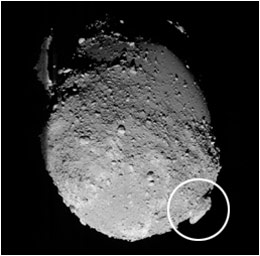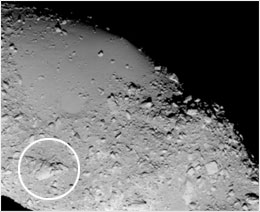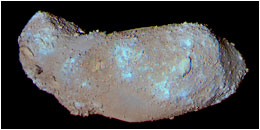 |
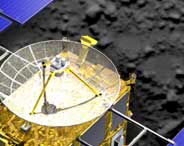 |
||
 |
 |
||
 |
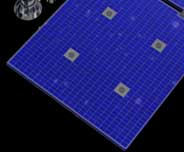 |
||
Itokawa looks as if it consists of two attached masses. The asteroid surface has two distinct surface types: a smooth zone with regolith (a layer of sand or gravel on the surface), and a bumpy zone, covered with a great number of rocks. It is the first time for such a naked asteroid, without regolith, to have been observed. A lot of rocks are seen in wide areas. The maximum size is as large as about 50m. Rocks are commonly believed to be fragments created from the birth of a crater on the surface. As far as we know today, the size of a crater is relative to the biggest fragment emitted out of it. According to that relativity, the 50-meter rock is too huge even for Itokawa's largest crater. This is a very important clue to studying the asteroid's formation history. It is safe to assume that a larger celestial body originally existed before Itokawa. And on its destruction, a fragment from it became Itokawa as other finer fragments piled on the asteroid surface. A cracking rock has also been found and studying the cause is on the agenda for future research. The regolith of the smooth-surface zone, which lays from the South pole to the North pole of Itokawa, has possibly gathered corresponding to the gravity distribution on the surface. As the area and particle size distribution of the regolith, rocks and craters are analyzed, we will get closer to finding the history of the impacts that Itokawa has experienced as well as the evolution of asteroids and the solar system. Itokawa's estimated density is a little lower than regular rock on Earth, which suggests the existence of bigger inner gaps than had been expected. It is uncertain whether the density is a result of the gaps within the rock or between rock piles. When samples from Itokawa are successfully retrieved, this will be clearer, giving us a better understanding of asteroid structure, and furthermore, of meteorites and the Earth. The image that emphasizes Itokawa's surface coloring shows slight color changes on different areas of its surface. They are currently being analyzed to find if the differences indicate different materials or space weathering (a phenomenon by which a planet reddens as the reflectance of the planet surface decreases due to, for example, space debris collisions). |
|||||
|

